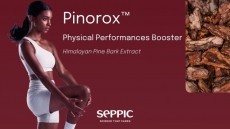Cocoa and red berries may improve cardiovascular health in aging adults

“Our study showed a positive modulation of microbiota metabolism after a regular intake of cocoa flavanols and red berry anthocyanins that led to an improvement in cardiovascular function, especially in the group that consumed cocoa,” they wrote in the journal Nutrients.
The research – led by the Department of Metabolism and Nutrition, Institute of Food Science and Technology and Nutrition (ICTAN-CSIC) in Madrid – was funded by the Spanish Agency for Research through the National Program for Research Aimed at the Challenges of Society (RETOS) program.
Cocoa flavonols and red berry anthocyanins
The study noted that polyphenol-rich cocoa and berries have been shown to be effective in combatting the effects of aging, especially in preventing the cognitive decline and the development of cardiovascular disease. The team’s own research previously demonstrated that regular intake of red berries, cocoa and a mixture of both improved executive functions in healthy adults.
“The aim of the present study was to analyze the effects of cocoa flavanols and red berry anthocyanins on cardiovascular biomarkers, such as homocysteine, angiotensin-converting enzyme (ACE), nitric oxide (NO), flow-mediated vasodilation (FMD), blood pressure and lipid profile,” the research team explained. “Additionally, we aimed to ascertain their possible interactions with microbiota related metabolites, such as secondary bile acids (SBA), short-chain fatty acids (SCFA) and trimethylamine N-oxide (TMAO).”
During aging, dysfunction of the vascular endothelium occurs, along with increased arterial thickening and stiffness, leading to an increased risk of developing hypertension, atherosclerosis and myocardial infarction. Consumption of cocoa flavonols and berry anthocyanins are therefore proposed as preventative strategy to support the vascular system since they regulate inflammatory and ROS-dependent signaling pathways associated with senescence.
Test products were prepared and supplied by Barcelona-based Salengei, a healthy aging supplement company.
Study details
The parallel-group study recruited 60 healthy men and women between the ages of 45 and 85 and randomized them to one of three groups. Participants consumed either 2.5 g/day of cocoa powder (9.59 mg/day of total flavanols), 5 g/day of a red berry mixture (13.9 mg/day of total anthocyanins) or 7.5 g/day of a combination of both for 12 weeks.
“The group that had consumed cocoa showed a significant reduction in TMAO and uric acid levels in serum, accompanied by an increase in FMD values and total polyphenols,” the study reported. “Additionally, we observed an increase in carbohydrate fermentation in the groups that had consumed cocoa and red berries between the beginning and the end of the intervention.”
This increase in carbohydrate fermentation (and therefore subsequent increase of SCFA synthesis) was correlated with lowered systolic and diastolic blood pressure, as well a decrease in the HDL to total cholesterol ratio.
The study suggested that the lack of effect of the cocoa-red berry mixture on the cardiovascular biomarkers studied could be attributed to “an unknown antagonistic interaction between red berry anthocyanins and cocoa flavanols”, since the dimeric structures of both can cross the intestinal barrier but not as efficiently as the isolated compounds.
For further study, the research team called for longer-term, placebo-controlled trials to clarify the effects of the compounds on SCFAs, SBAs and other cardiovascular parameters, such as ACE activity and NO concentrations, along with an in-depth study of gut microbiota regulation.
Source: Nutrients 2023, 15(10), 2299
“Regular Consumption of Cocoa and Red Berries as a Strategy to Improve Cardiovascular Biomarkers via Modulation of Microbiota Metabolism in Healthy Aging Adults”
doi: doi.org/10.3390/nu15102299
Authors: Joaquín García-Cordero et al.
















